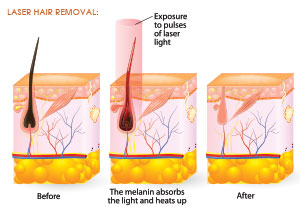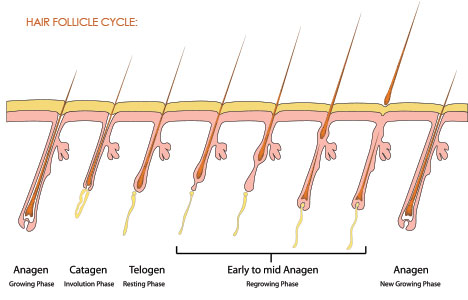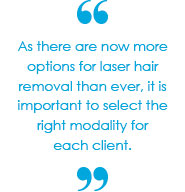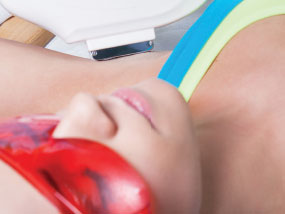 How it Works
How it Works
Laser hair removal works by targeting the hair follicle’s melanin. By using the appropriate settings to focus energy on the melanin in the deep part of the hair follicle where the hair grows, the melanin can be heated up high and long enough to destroy the hair follicle. Thus, laser hair removal targets dark terminal hairs that are in the early growth (or anagen) phase of the hair cycle.
Client Selection
Laser hair removal has different effects on different hair and skin colors. There are many symptoms that come with the treatment. There are some types of clients that should avoid laser hair treatment all together.
Dark Hair – Laser hair removal targets dark hairs. White hairs are not affected and blonde or red hairs are very difficult to treat. Light hairs are better-treated by electrolysis, in which a needle delivers electrical current to destroy hair follicles individually. Topical eflornithine (Vaniqa®) can also be used to slow down the growth of hair, whether light or dark. It is a prescription cream that is Federal Drug Administration (FDA)-approved for unwanted facial hairs, and is best used in combination with a hair removal method.
Fair skin – Laser hair removal works best on fair skin because the laser can better target the melanin in the hair follicle. In clients with darker skin, the laser has the potential to target melanin in the skin, leading to scarring and pigmentary changes. Therefore, caution must be used when selecting a laser on clients with darker skin (skin that tans more easily than it burns).
Small to Large Areas – Laser hair removal targets several hairs in a given field with each pulse. Therefore, it is ideal for small to large areas like the upper lip, chin, back, bikini area, and legs. It is not ideal for single hairs, in which case electrolysis is preferable.
Associated Symptoms – Unwanted hair growth can sometimes be a symptom of a much larger medical problem such as a hormonal disorder. Clients with an associated medical condition can still undergo laser hair removal, but they also require medical treatment to help their condition. Ask clients about any menstrual irregularities or increased acne and always refer to a physician when in doubt.
Photosensitivity – Avoid clients with photosensitivity. Ask if they have an underlying medical condition or take a medication that makes them more sensitive to light. In this case, it is best to avoid laser hair removal or postpone treatment until after the medication has been stopped.
Pregnancy – Avoid pregnant clients. Laser hair removal is safe during pregnancy, but since it is an elective procedure it is best to save this treatment until after pregnancy.
Keloids – Avoid clients with keloids (enlarged scars). If clients have had keloids in reaction to other procedures, like piercings or tattoos, then they may not be good candidates for laser hair removal.
Client Preparation
There a few things that clients need to avoid when preparing for their laser hair removal treatment. If any of the activities are done by the client, the treatment results could be altered.
No tanning. Since laser hair removal targets melanin, the skin should be as pale as possible in order to focus energy on the melanin in the hair follicles and not in the skin.
No tweezing, waxing, threading, or any other type of epilation in the area to be treated for four weeks prior to laser hair removal treatment. However, since the deep portion of the hair is still in place, shaving or trimming of hair is fine.
Ask about herpes outbreaks. If clients have had cold sores or herpes in the areas to be treated (like around the mouth or in the genital area), pre-treat with oral anti-viral medication.
Consider recent retinoid use. Clients should be off isotretinoin (formerly Accutane®) for at least one month prior to treatment. Topical retinoids, like tretinoin or tazarotene, should be stopped one to two days prior to treatment, if used in the area to be treated. 
Laser hair removal has been likened to a rubber band snap. Most people experience mild pain and do not need any pain control. However, everyone’s pain threshold is different. People can take an acetaminophen on the day of the procedure. Numbing cream can be used to the area to be treated 30 to 60 minutes prior to the procedure. However, caution must be used when applying topical anesthetic to large areas, such as the back and legs, or under occlusion, since toxicity and even death can occur. Always follow package instructions carefully.
All clients should be aware of the risks and benefits of any procedure they are about to undergo, and be able to agree to the treatment.
 Device Selection
Device Selection
There are many different types of lasers used for laser hair removal, such as long-pulsed alexandrite (755 nm), long-pulsed diode (800 to 810 nm), long-pulsed ruby (694 nm), and long-pulsed Nd:YAG (1064 nm). Intense pulsed light (IPL) is also available, while not truly a laser as it uses multiple wavelengths of light to provide energy (400 to 1200 nm). Recent at-home devices use the IPL technology, but require many more treatments compared to in-office use devices. To best select the type of laser for each client, use the Fitzpatrick scale as reference.
Fair Skin (Fitzpatrick skin types I, II and III) – Any device can be used in clients with fair skin. Side effects are the lowest with the long-pulsed alexandrite laser, followed by IPL and the long-pulsed diode laser. Therefore, the lasers are preferred in this order. The long-pulsed ruby laser was the first device used for laser hair removal and is another option for fair skin.
Dark Skin (Fitzpatrick skin types IV, V and VI) – Long-pulsed Nd:YAG is the best option for clients with darker skin, although the long-pulsed diode and long-pulsed alexandrite have also been used in these clients. The combination of laser with radiofrequency is also a safe alternative for clients with darker skin since it minimizes the laser energy required to destroy the hair follicle, thus decreasing the risk of scarring and pigmentary alteration. Most lasers have a built-in, skin-cooling device to minimize pigmentary damage in the skin; this step is especially important in clients with darker skin.
Device Settings
Each device comes with its own guidelines, which should always be followed. Test spots are also a good way to balance safety and efficacy, especially before treating an exposed or large area on clients with dark skin. Knowledge of the device settings are crucial to implementing proper laser hair removal treatments.
Fluence is the amount of energy delivered per unit area (in Joules/cm2). Higher fluences lead to more permanent hair removal, but can also cause pigmentary alteration. While staying within fluence guidelines, increase the fluence until mild redness and swelling is seen around the treated hair follicles within a few minutes of treatment.
Pulse duration refers to the amount of seconds of laser exposure. The amount of pulse duration required is determined by the size of the laser target; in this case, the melanin in the hair follicle. For clients with dark skin, a longer pulse duration is preferred to target melanin in the hair follicle rather than melanin in the skin.
Spot size is the diameter of the laser beam in millimeters. Studies have shown that larger spot sizes scatter less light, so larger spot sizes are preferable to smaller ones.
Laser Safety
Because the devices used for laser hair removal target the pigment melanin, they could potentially target pigment in the retina and cause eye damage. For this reason, clients, operators, and anyone in the treatment room must use protective eyewear when the laser is in use. The eyewear is specific to the wavelength of each laser, so ensure that the eyewear protects against the wavelength of the device in use.
Managing Client Expectations
Counsel clients appropriately so that they understand that laser hair removal provides hair reduction, but not permanent hair removal. Clients can expect to have treated hairs fall out in one to three weeks. Sometimes the hairs appear longer as they dislodge, but reassure clients that these hairs will fall out. They should not intentionally pull or remove hairs as this can increase irritation.
Under optimal treatment parameters, clients can expect to lose 15 to 30 percent of hairs in each treatment session. Because each hair follicle undergoes a growth cycle that consists of growing (anagen), resting (catagen), and shedding (telogen) phases and because lasers only target hairs in the early growing phase, laser hair removal cannot treat all hairs in one treatment.
Most clients require four to seven treatments spaced three to eight weeks apart in order to see a 70 to 80 percent reduction in hair growth. Typically, annual maintenance treatment is needed for a few years. However, everyone is different, and some clients will notice regrowth in a few months, whereas others will never need to shave again.
 Potential Complications
Potential Complications
As with many skin treatments, there are some complications that can arise after laser hair removal. The complications vary from client to client.
Redness and swelling are the most common side effects, however, they only last a few days. Cool compresses and topical steroids can be used to hasten symptoms.
If the settings are too high, scarring with pigmentary alteration (hyper- or hypopigmentation), blisters, and burns are possible, especially in clients with dark skin. Scarring may be temporary or permanent. All clients, especially those with any pigmentary alteration, should avoid sunlight for one week after treatment.
If the settings are too low, temporary (rather than permanent) hair loss is possible. Because laser hair removal destroys hair follicles by targeting melanin in the deep part of the hair follicle, if not enough energy is used, the hair follicle can be impaired, but not destroyed. In this case, the hair enters the resting (catagen) phase. It becomes thinner and temporarily stops growing, but eventually the hair will return.
Lasers can paradoxically cause increased hair growth on the face in certain women, especially those with dark skin when lower fluences (energies) are used. This occurs because fine, vellus hairs are converted to more obvious, terminal hairs. It is important to follow device guidelines appropriately and inform clients of this potential complication.
While laser hair removal can help prevent acne and folliculitis by removing the hair follicule, these conditions can sometimes be flared immediately after laser hair removal treatment. Flares can be treated with acne medications such as salicylic acid or benzoyl peroxide wash.
If a client barely responds to laser hair removal, it is important to make sure that a hormonal imbalance is not being missed. Any client who is not improving should be referred to a board-certified dermatologist.
When the optimal parameters on the appropriate device are used for each client, laser hair removal provides a safe and effective method of decreasing unwanted hair. As the popularity of laser hair removal increases, it is ever more important to become familiar with the array of options to direct clients to the appropriate treatment modality.
 Kristin D. Hudacek, M.D. is a board-certified dermatologist and fellow of the American Academy of Dermatology. She works in private practice with Richard G. Glogau, M.D. in San Francisco, Calif. Her professional interests include cosmetic, procedural, and medical dermatology. A native of the East Coast, Hudacek attended Princeton University and the University of Pennsylvania School of Medicine. She completed her dermatology residency in Philadelphia, Pa. at Drexel University College of Medicine/Hahnemann University Hospital. In her personal time, she enjoys spinning, yoga, and finding the perfect falafel.
Kristin D. Hudacek, M.D. is a board-certified dermatologist and fellow of the American Academy of Dermatology. She works in private practice with Richard G. Glogau, M.D. in San Francisco, Calif. Her professional interests include cosmetic, procedural, and medical dermatology. A native of the East Coast, Hudacek attended Princeton University and the University of Pennsylvania School of Medicine. She completed her dermatology residency in Philadelphia, Pa. at Drexel University College of Medicine/Hahnemann University Hospital. In her personal time, she enjoys spinning, yoga, and finding the perfect falafel.
